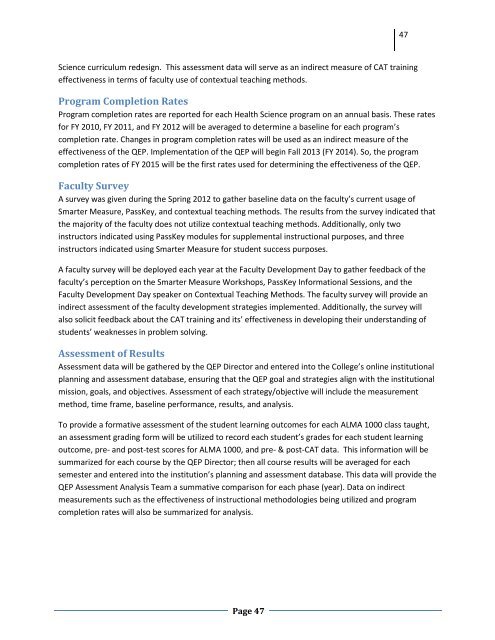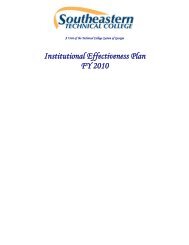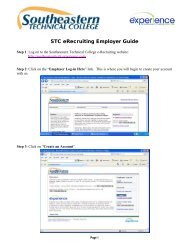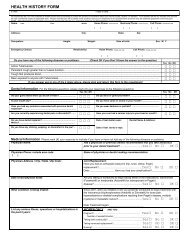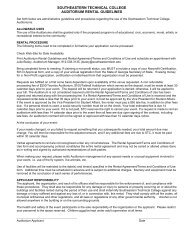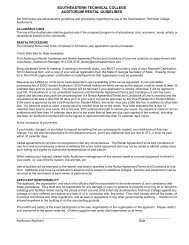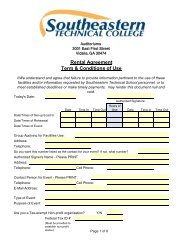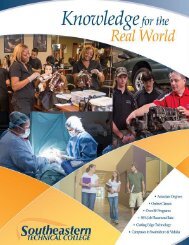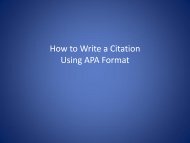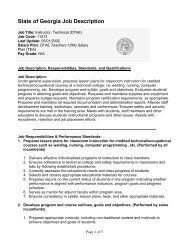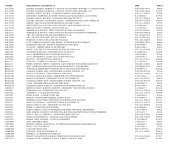Click for PDF of QEP Document - Southeastern Technical College
Click for PDF of QEP Document - Southeastern Technical College
Click for PDF of QEP Document - Southeastern Technical College
- No tags were found...
Create successful ePaper yourself
Turn your PDF publications into a flip-book with our unique Google optimized e-Paper software.
47Science curriculum redesign. This assessment data will serve as an indirect measure <strong>of</strong> CAT trainingeffectiveness in terms <strong>of</strong> faculty use <strong>of</strong> contextual teaching methods.Program Completion RatesProgram completion rates are reported <strong>for</strong> each Health Science program on an annual basis. These rates<strong>for</strong> FY 2010, FY 2011, and FY 2012 will be averaged to determine a baseline <strong>for</strong> each program’scompletion rate. Changes in program completion rates will be used as an indirect measure <strong>of</strong> theeffectiveness <strong>of</strong> the <strong>QEP</strong>. Implementation <strong>of</strong> the <strong>QEP</strong> will begin Fall 2013 (FY 2014). So, the programcompletion rates <strong>of</strong> FY 2015 will be the first rates used <strong>for</strong> determining the effectiveness <strong>of</strong> the <strong>QEP</strong>.Faculty SurveyA survey was given during the Spring 2012 to gather baseline data on the faculty’s current usage <strong>of</strong>Smarter Measure, PassKey, and contextual teaching methods. The results from the survey indicated thatthe majority <strong>of</strong> the faculty does not utilize contextual teaching methods. Additionally, only twoinstructors indicated using PassKey modules <strong>for</strong> supplemental instructional purposes, and threeinstructors indicated using Smarter Measure <strong>for</strong> student success purposes.A faculty survey will be deployed each year at the Faculty Development Day to gather feedback <strong>of</strong> thefaculty’s perception on the Smarter Measure Workshops, PassKey In<strong>for</strong>mational Sessions, and theFaculty Development Day speaker on Contextual Teaching Methods. The faculty survey will provide anindirect assessment <strong>of</strong> the faculty development strategies implemented. Additionally, the survey willalso solicit feedback about the CAT training and its’ effectiveness in developing their understanding <strong>of</strong>students’ weaknesses in problem solving.Assessment <strong>of</strong> ResultsAssessment data will be gathered by the <strong>QEP</strong> Director and entered into the <strong>College</strong>’s online institutionalplanning and assessment database, ensuring that the <strong>QEP</strong> goal and strategies align with the institutionalmission, goals, and objectives. Assessment <strong>of</strong> each strategy/objective will include the measurementmethod, time frame, baseline per<strong>for</strong>mance, results, and analysis.To provide a <strong>for</strong>mative assessment <strong>of</strong> the student learning outcomes <strong>for</strong> each ALMA 1000 class taught,an assessment grading <strong>for</strong>m will be utilized to record each student’s grades <strong>for</strong> each student learningoutcome, pre- and post-test scores <strong>for</strong> ALMA 1000, and pre- & post-CAT data. This in<strong>for</strong>mation will besummarized <strong>for</strong> each course by the <strong>QEP</strong> Director; then all course results will be averaged <strong>for</strong> eachsemester and entered into the institution’s planning and assessment database. This data will provide the<strong>QEP</strong> Assessment Analysis Team a summative comparison <strong>for</strong> each phase (year). Data on indirectmeasurements such as the effectiveness <strong>of</strong> instructional methodologies being utilized and programcompletion rates will also be summarized <strong>for</strong> analysis.Page 47


